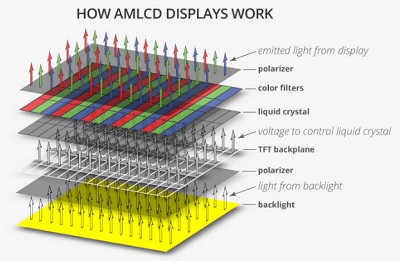LCD Backlight Trends
LCD display itself doesn't produce light. It relies on backlight to illuminate its pixels, especially in a high ambient light environment. Before we get to LCD backlight trends, we should go over its history.
LCD backlight history
In early days, incandescent light bulb was used as light source for LCD. But it was quickly replaced, because of the heat it generates and energy it consumes.
Cold Cathode Flourescent Lamp (CCFL) and Electroluminescent Panel (ELP) were the challenger, which get rid of heat problem from incandescent light bulb and consume less power.
LED backlight is now the dominant player. It provides shorter ON/OFF time, lesser generated heat and higher brightness.
The new trends
Most of today's LCDs use edge-lit backlighting. Several white LEDs are mounted behind one edge of the LCD screen, sending light into a complex setup of light guides, reflectors and diffusers. The LED backlight is usually driven by a Pulse Width Modulated signal to control the screen brightness.

Invented by LCD TV manufacturers, active matrix mini LED backlight is now moving down to consumer and industrial LCD applications. In the structure of mini LED backlit display, mini LEDs serve as backlight sources are arranged in arrays to form different local dimming zones that enable full brightness or darkness for the above LCD display to achieve high brightness and contrast.
The application of mini LED as backlight of LCD display boasts high contrast ratio, power conservation and thinning advantages, able to compete with OLED and show distinct performances in LCD display applications.
